Sinus lifting and simultaneous implantation
- Tutorial

Dear friends, in the previous articles, we discussed with you what kind of wisdom teeth are and how the removal of these very teeth goes . Today I would like to get a little distracted and talk about implantation, and in particular simultaneous implantation, when the implant is inserted directly into the socket of the extracted tooth and about sinus lift, an increase in the volume of bone tissue in height. This is required when installing implants in the area of 6, 7, less often 5 teeth on the upper jaw. Bone growth is required because there is a cavity on the upper jaw - the maxillary sinus. Most often, it occupies most of the upper jaw, and the distance from the edge of the bone to the bottom of this sinus is not enough to install the implant of the desired length.
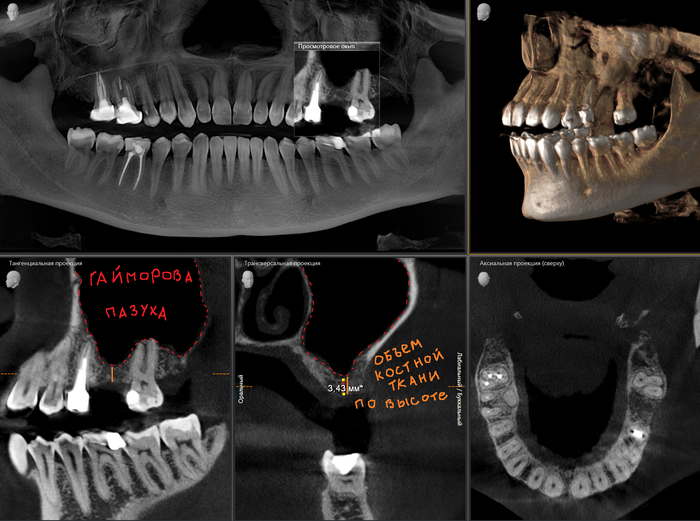
Computed tomography clearly shows that there is a failure in the area of the missing tooth.
Often I hear doctors say, “No, no, no, you can't put an implant right away! First, we remove the tooth, and how everything heals, then we will establish it! ” A reasonable question - why? Yes, who knows. Most interesting. Either because of the uncertainty in the forecasts, or because of the fear of complications, which, in fact, are no more than during the classical operation. Of course, with the condition that everything is done correctly. In my practice, the percentage of simultaneous implantation relative to the classical approach is about 85% to 15%. Agree, not a little. Where almost every operation in which tooth extraction is indicated ends with implantation. An exception is only acute inflammation in the area of the causative tooth, when pus flows mixed with snot. Or, when the implant is completely unstable and hangs in the hole, like a pencil in a glass. Financial opportunities also play an important role. Anyone will spend money with a greater desire for anything, but not for teeth. You can’t argue with that. But there is one “But”! You must understand that the more time passes from the moment a tooth is removed to the start of prosthetics, the worse the conditions for staging this implant itself. As the saying goes: - "a holy place does not happen empty." Over time, a number of wildest problems appear, which also have to be addressed. And this is always additional, and often considerable, expenses. Do you need it? Over time, a number of wildest problems appear, which also have to be addressed. And this is always additional, and often considerable, expenses. Do you need it? Over time, a number of wildest problems appear, which also have to be addressed. And this is always additional, and often considerable, expenses. Do you need it?
Well! Let's move on to the examples.
The simplest case of simultaneous implantation is a single-root tooth. Be it the upper or lower jaw.
This computed tomography was done before the tooth finally fell apart.
What do we see?
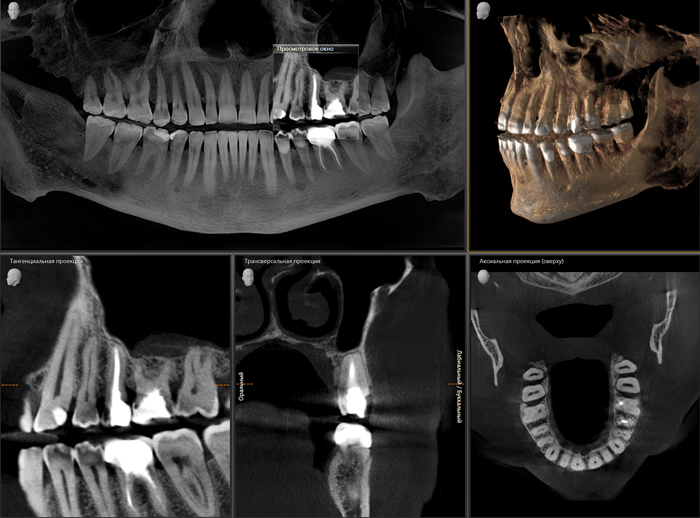
Upper left 5, not subject to either therapeutic or orthopedic treatment. What are we doing? That's right - remove the tooth and screw in the bolt.
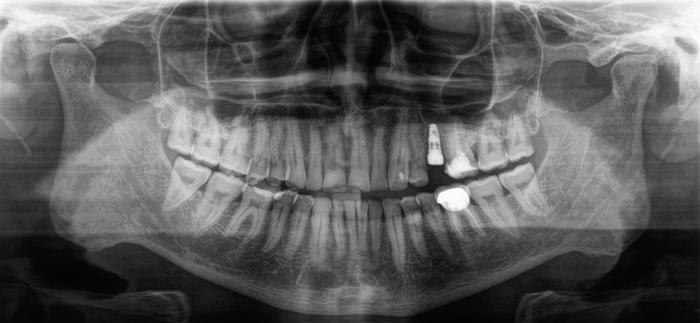
I performed a gentle, atraumatic tooth extraction and installed an implant with a gingiva former.
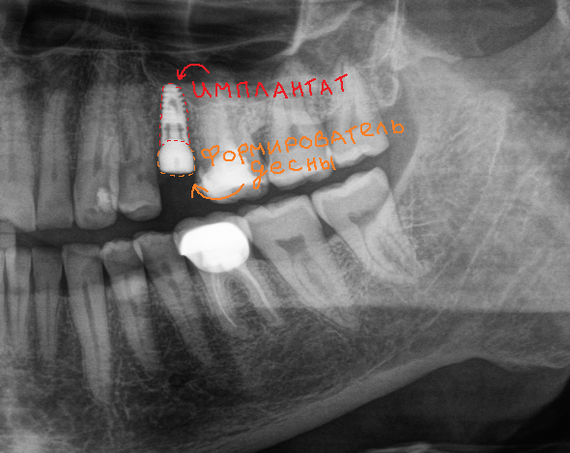
The gingiva former is something like a low (on average 3 mm. In height), metal hemp that sticks out a little above the level of the gum, thereby forming its contour before installing the crown. It looks something like this:
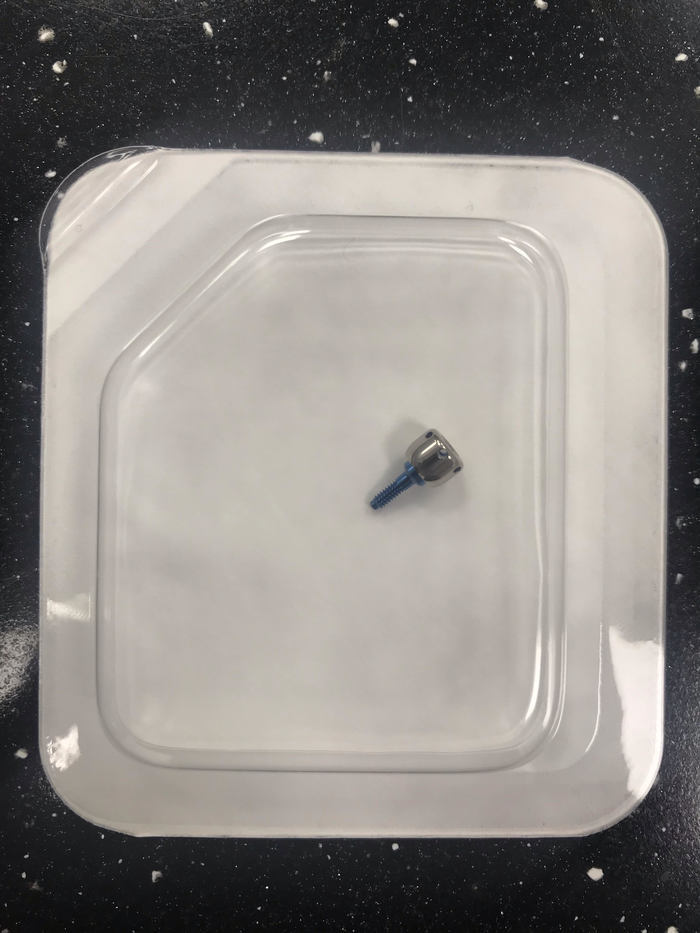
And the implant itself looks like this:
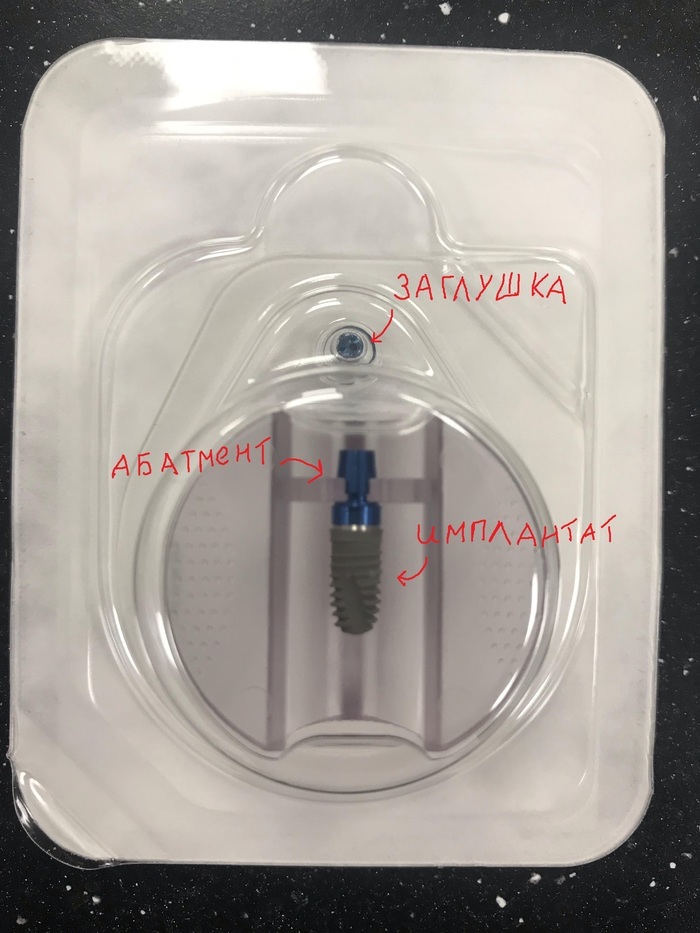
The gray part is the implant itself. The blue part is the so-called temporary abutment, on which you can fix the temporary crown, if implantation is accompanied by immediate loading. Basically, this abutment acts as an implant holder. After the implant is installed, the abutment is twisted, like a designer, with a special screwdriver, and a plug is screwed in its place. It is installed if it is not possible to immediately install the healing abutment. Then the implant and all its components are completely under the gum, which means that after the operation we will not see anything in the oral cavity. Well, except for the stitches and ... the rest of the teeth, if they still remain. In this situation, the former is installed after the implant has taken root.
Next, select the next level of difficulty when you have to remove the 6th tooth on the lower jaw. This tooth is two-root. Of course, we will not install on the implant in the area of each root, as someone might think. Although I saw similar cases. The doctor, apparently, was burning a mortgage loan.
So, we need to install one implant, but clearly in the center. We will aim at the bony septum between the two roots.
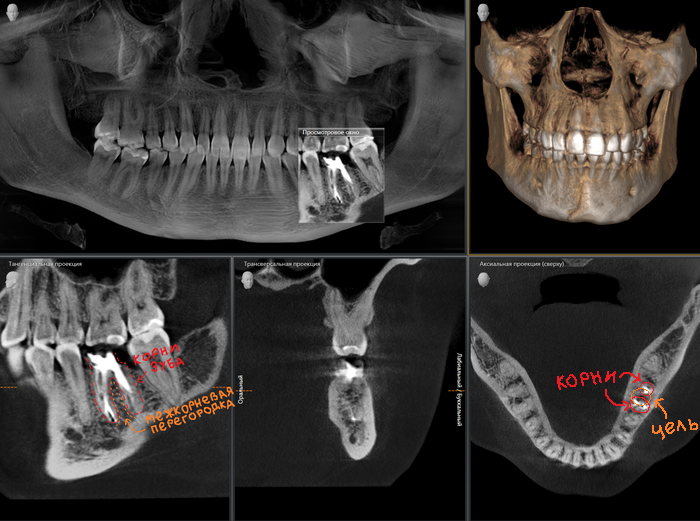
We install the implant. To the left and to the right of it in the picture are clearly visible the holes from the tooth just removed, which, as they heal, will be tightened.
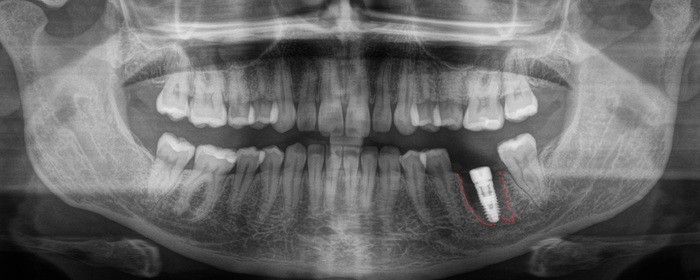
Well, it's time to consider the case when you need to remove a tooth, install an implant and carry out bone tissue extension on the upper jaw - sinus lift. And the level of complexity, meanwhile, is increasing. Not a mission with helicopters from Vice City, of course, but you have to be a little more careful than in the previous case.
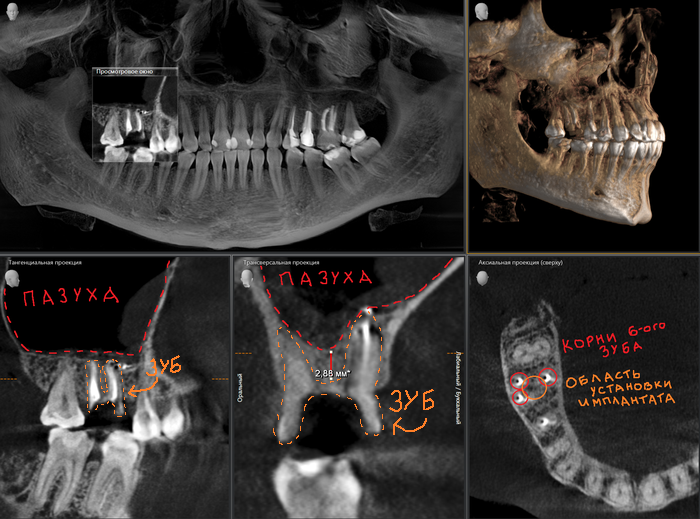
Remember, I said that the implant should be centered? So the 3rd root tooth is no exception. The implant is installed, as in the previous case, into the septum, but with a three-root tooth. As we see the bone height in this area is about 3mm. This volume is not enough for the placement of the implant of optimal length, therefore, the volume must be increased. Manipulation is carried out using a special "bone material". Someone calls it “bone powder”, not to be confused with “white powder”, although it is white, but is still presented in the form of granules. It is produced both simply in a glass container
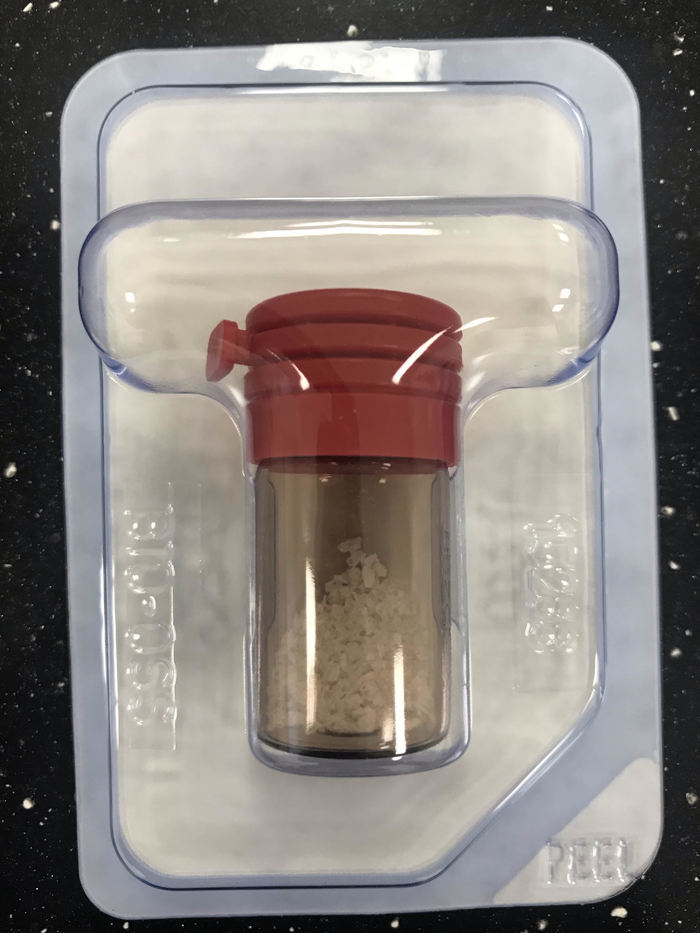
and in a more convenient form - special syringes, with the help of which it is more convenient to work and introduce material into the surgical field.
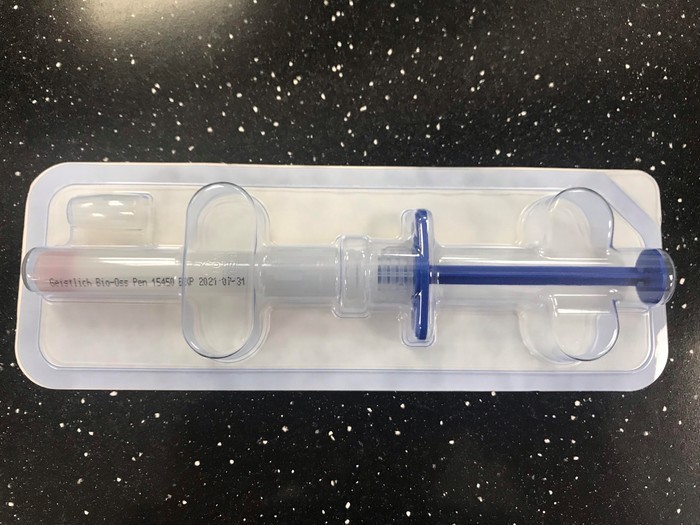
It is a mistake to believe that sinus lift is an operation “B” in the maxillary (maxillary) sinus. In fact, the manipulation is carried out "under" her. As we already found out, the sinus is a cavity in the upper jaw, a void, if you want, that is lined with a thin mucous membrane with a ciliated epithelium from the inside. So, in order for the operation to be removed, a local detachment of the mucous membrane from the bone tissue is carried out and “bone material” is placed in the formed space between the bottom of the sinus and the mucous membrane, like in an envelope. In this case, with the parallel installation of the implant.

And now an example of sinus lift and implantation, but 2 months after the 6th tooth in the upper jaw was removed. This patient was removed 6-ku about a week ago in another clinic. The assistant did a CT scan.

Due to the fact that only a week has passed after the removal, then in the picture we see a “dark hole”, like the one that the former left in your heart. In the place where the tooth used to be. That is, there is no bone tissue in this area. I started the operation after 2 months. Repeated computed tomography after healing of the hole was not done, but believe me, everything healed enough to be able to carry out the operation. During the operation, the implant could not be tightly stabilized, so I decided to install a stub, not a gum former. Why? But because if the patient begins to gnaw crackers, then the implant, in particular the shaper, can be exerted strong pressure, in connection with which the implant can become loose or “fly away” into the sinus. At the same time, 8 went into the junk.
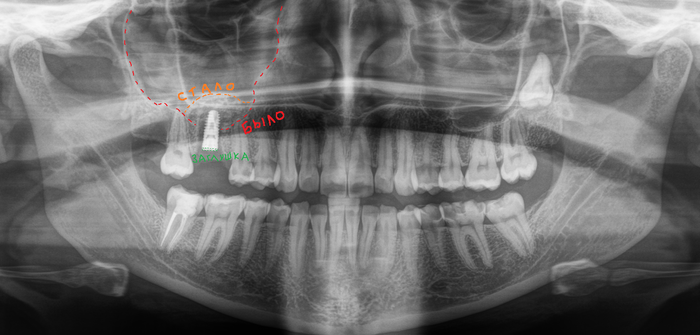
Well, the last example for today is the removal of 2 teeth, the installation of 2 implants and sinus lift.
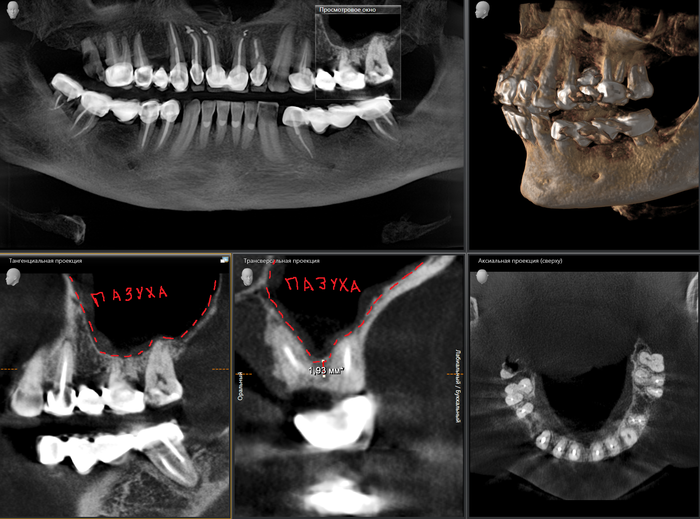
As we see the conditions in this case are slightly worse than about 2mm. But this did not stop us from conducting the operation in full.
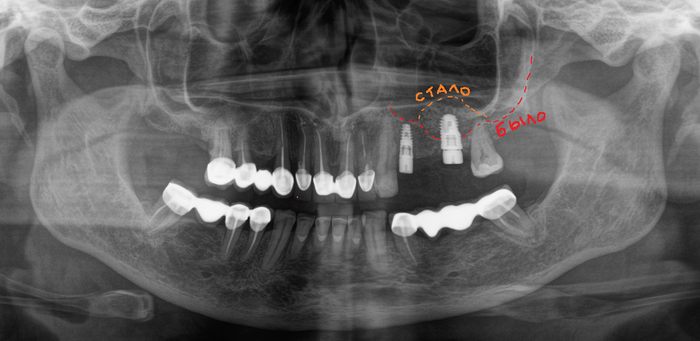
You may ask: - “Why are there 2 implants, and not 3?” “What, will there be a bridge?” “But what about the load distribution,” and so on?
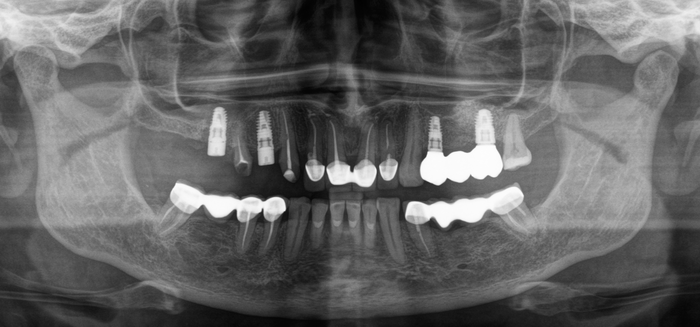
In fact, the problem of overloads associated with bridges concern only their teeth. Since the teeth have a ligamentous apparatus. That is, the tooth is not tightly fused to the bone, but as if springing in it. Here is the diagram:
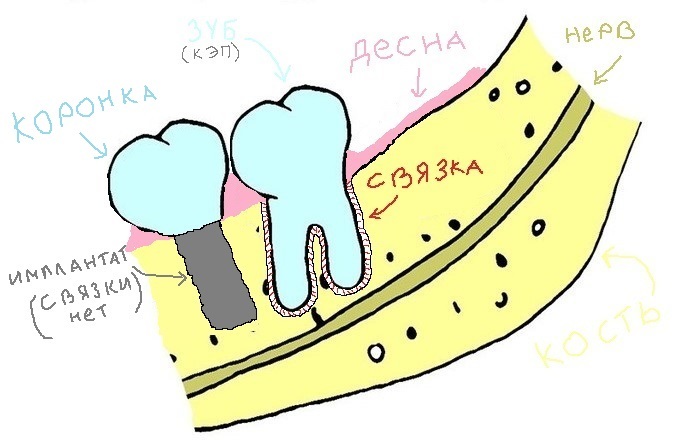
In the presence of a bridge, the abutment teeth take on both their own load and the load of the tooth that is missing. Thus, an overload of the teeth develops, and after they turn out to be at the tooth fairy. The implant does not have such a ligament. It tightly fuses with the surrounding tissues, so there are no similar problems, as in the case with his teeth. But this does not mean that you can install a huge bridge on the entire jaw on two implants. The only thing that suffers in the presence of bridges is hygiene, it will need to be monitored especially carefully. Because it’s much easier to take care of freestanding teeth than similar prostheses.
That, in fact, is all for today. I will be glad to answer your questions!
Stay tuned!
Sincerely, Andrey Dashkov
What else to read about dental implants?
- Implant placement: how is this done?
- Implantation in the complete absence of teeth, as a result of untimely visits to the dentist
